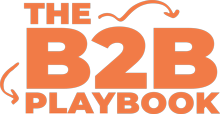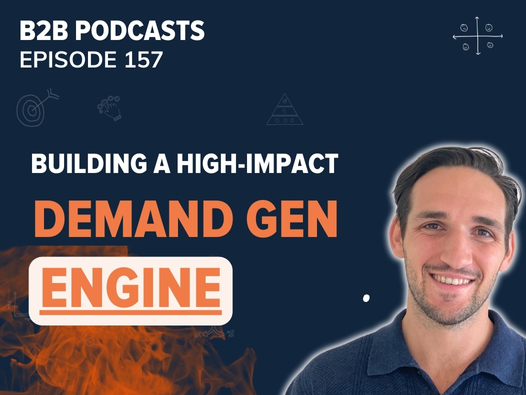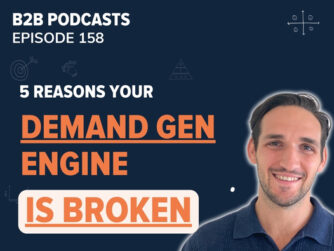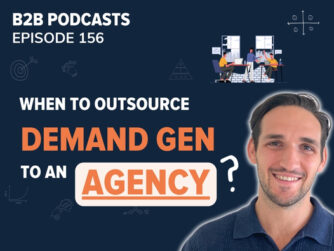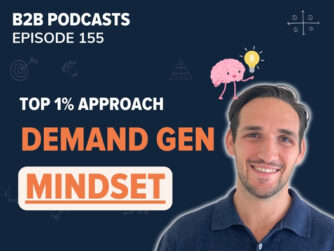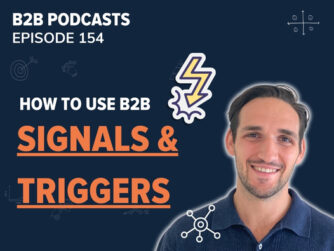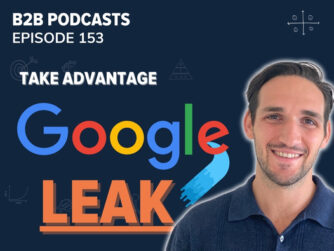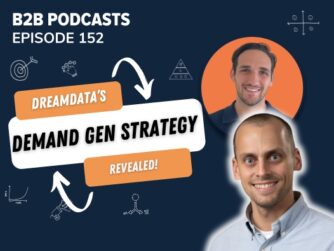Demand generation has become a buzzword in B2B marketing that gets thrown around a lot, but how many of us are really nailing it? We’re all after the same thing—growth, right? Yet so many marketers are still stuck in the lead gen hamster wheel, running after short-term wins at the expense of building sustainable, long-term growth.
The truth is, demand generation isn’t just another marketing tactic. It’s a shift in mindset. It’s about playing the long game, creating real connections with your audience, and staying top-of-mind until they’re ready to buy. In this article, I’ll share insights from a conversation I had recently as a guest on a podcast, where we unpacked what demand generation really is and how B2B marketers can use it to drive lasting success.
Stick around, and I’ll walk you through why most businesses get it wrong, the key elements that make up a solid demand generation strategy, and how you can build demand a demand engine like a pro—even if you’re part of a small team with limited resources.
We also cover how ABM fits into Demand Generation, and a little sneak peak as to how we’re using GenAI today to help us with Demand Gen.
Listen To The Episode
Watch The Episode
What is Demand Generation?
Demand generation is one of those things that sounds simple, but there’s a lot of misunderstanding around it. At its core, it’s about creating a desire for your product or service within your target audience. And I don’t just mean getting leads into the pipeline; I’m talking about playing the long game – building a genuine connection and staying top-of-mind until the moment they’re ready to buy.
When we break it down, demand generation is made up of two key parts: generating demand and capturing demand. Demand capture is where most businesses start – it’s about targeting that small percentage of people who are actively looking to buy right now. In fact, it’s only about 3 to 5 percent of your total market. If you’re relying solely on this, you’re in a bloodbath with your competitors. Everyone’s fighting for the same slice of the pie, and it gets expensive—fast.
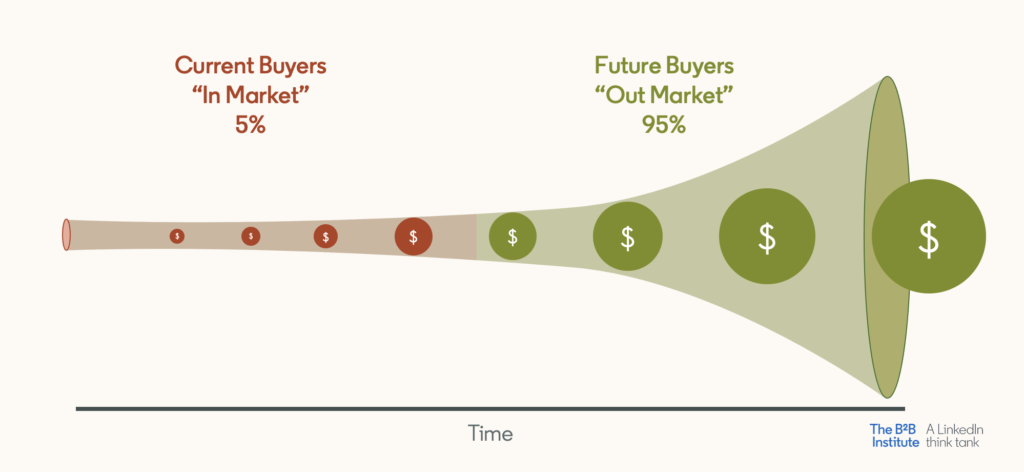
That’s where demand creation comes in – i.e. reaching future buyers. It’s about being visible and helpful to the other 95 percent of the market who aren’t ready to buy yet. These are the folks who might not even know they have a problem, let alone that your product is the solution. Your goal is to educate them, build trust, and position your brand so that when the time comes, they’re thinking of you—not your competitors. That’s how you create sustainable growth.
“Demand generation is about being in front of your target market before they know they need you. So when they’re ready to buy, they come to you, not your competitors”
George Coudounaris – The B2B Playbook
The bottom line is, if you want to scale, you can’t just chase short-term wins with demand capture. You need a balanced approach that invests in demand generation with future buyers for the long-term success of your business.
(P.S. we go in-depth into what is demand generation in an article here)
The “Bloodbath” of Capturing Demand Alone
Let’s talk about ‘capturing demand’ for a second. It’s where most B2B marketers start, right? You run a Google Ads campaign, trying to capture those searching for a product/solution like yours right now. And for good reason—when you’re looking for quick results, lead gen seems like the obvious choice. But here’s the problem: it doesn’t scale. You’re stuck competing for the same small pool of prospects as every one of your competitors. It’s brutal. In fact, I often describe it as a “bloodbath” because of how intense the competition gets.

You might start out strong, targeting those high-intent buyers—people who are actively searching for solutions like yours. But what happens when you’ve exhausted that pool? You begin to stretch, broadening your targeting, going after lower-intent audiences, and suddenly, things get a lot harder. And more expensive. Those cost-per-clicks skyrocket, your sales team starts getting lower-quality leads, and you’re left fighting for attention in a crowded space.
This is the trap a lot of marketers fall into. They get stuck in a cycle of chasing leads without stepping back to think about the long-term strategy. Yes, lead generation and demand capture has its place, but if you rely on it too much, you’re going to hit a wall. You’re constantly fighting for short-term wins, and as your competitors do the same, it becomes a race to the bottom.
Lead gen alone isn’t enough to fuel sustainable growth. You’ve got to move beyond the bloodbath and start thinking about how to create demand with future buyers, not just capture it. That’s how you build a business that lasts.
Demand Gen Challenge: The Great Divide Between Sales and Marketing
A big challenge to getting ‘buy-in’ from Sales and Leadership on Demand Generation often comes down to the disconnect between sales and marketing. It’s something I hear about from almost every marketer I speak to, and honestly, it’s not getting a lot better. I call it the “Great Divide.” Marketing teams are being forced into a corner, handcuffed to lead generation efforts, while sales teams are left with low-quality leads that they can’t convert. This just deepens the mistrust between the two teams.
A lot of this misalignment comes from the top down. B2B SaaS companies, for example, are notorious for pushing this high-volume, lead-at-all-costs mentality. Sales teams want leads, and they want them fast, so the marketing team gets pressured into generating quantity over quality. But what happens? Sales ends up with a pile of leads they don’t trust, and the marketing team doesn’t get the chance to do real marketing—building demand and nurturing relationships.

To make matters worse, the way sales and marketing are measured only fuels this divide. Sales gets compensated based on closed deals, while marketing is stuck proving the ROI of every activity. But demand generation doesn’t always have an immediate return, so the pressure forces marketing to double down on short-term lead gen tactics.
“We need to be acting as one go-to-market team, but the way sales and marketing are compensated and measured just doesn’t encourage that at all”.
George Coudounaris – The B2B Playbook
If we want to fix this, we need to align sales and marketing around the same goals—working as a unified team, not in silos. It starts with having shared definitions, like what actually makes a lead “qualified” and setting up clear communication between both sides. Until then, we’ll keep seeing this divide grow.
We built a guide on aligning your Sales & Marketing teams. Grab it for free, (ungated of course) here.
How to Allocate Your Budget for Demand Generation
Yes, capturing demand might get you some quick wins, and if it’s working for you, great—keep doing it. But if that’s all you’re doing, you’re setting yourself up to hit a wall. At some point, the leads dry up, or they start becoming more expensive and harder to convert. You’re missing out on sustainable growth because you’re not reaching enough future buyers that will fuel your pipeline for the long haul.
What I often recommend to marketers in this position is to start small. You don’t have to overhaul your entire strategy overnight—that’s not realistic. Instead, carve out just 10 percent of your existing budget and time to focus on demand generation. Choose a narrow product or a specific segment to start with, prove that you can generate demand, and then scale from there. This way, you’re still meeting your short-term needs while also laying the groundwork for future growth.
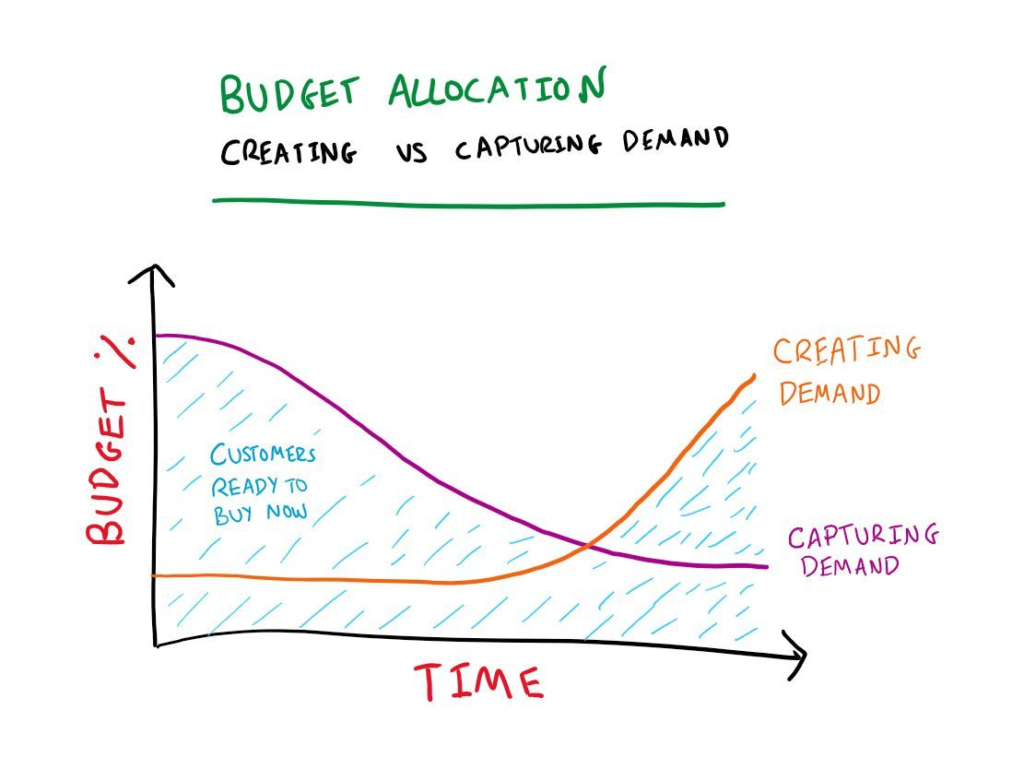
At the end of the day, it’s about finding balance.
“If all your effort goes into short-term tactics, you’re missing the bigger picture—building demand for the future”.
George Coudounaris – The B2B Playbook
Demand generation is the long game, and the sooner you start, the more stable your growth will be down the line.
The 5 BEs Framework for Demand Generation
So how do you actually go about building a Demand Generation engine? When I first started in B2B marketing, I couldn’t find a straightforward, step-by-step guide. I was piecing together tactics from blogs, testing strategies, and learning through trial and error. That’s why we created the 5 BEs Framework—it’s the framework we wish we had when we started out, and it’s designed to help marketers build sustainable demand without getting lost in all the noise.
The first three BEs—Be Ready, Be Helpful, and Be Seen—are the foundation. These are the fundamentals, and if you get these right, everything else falls into place. Be Ready is all about knowing your customers inside and out. Who are your best customers? What are their pain points? How do they make decisions? Once you know that, you can position your business as the obvious solution to their problems.
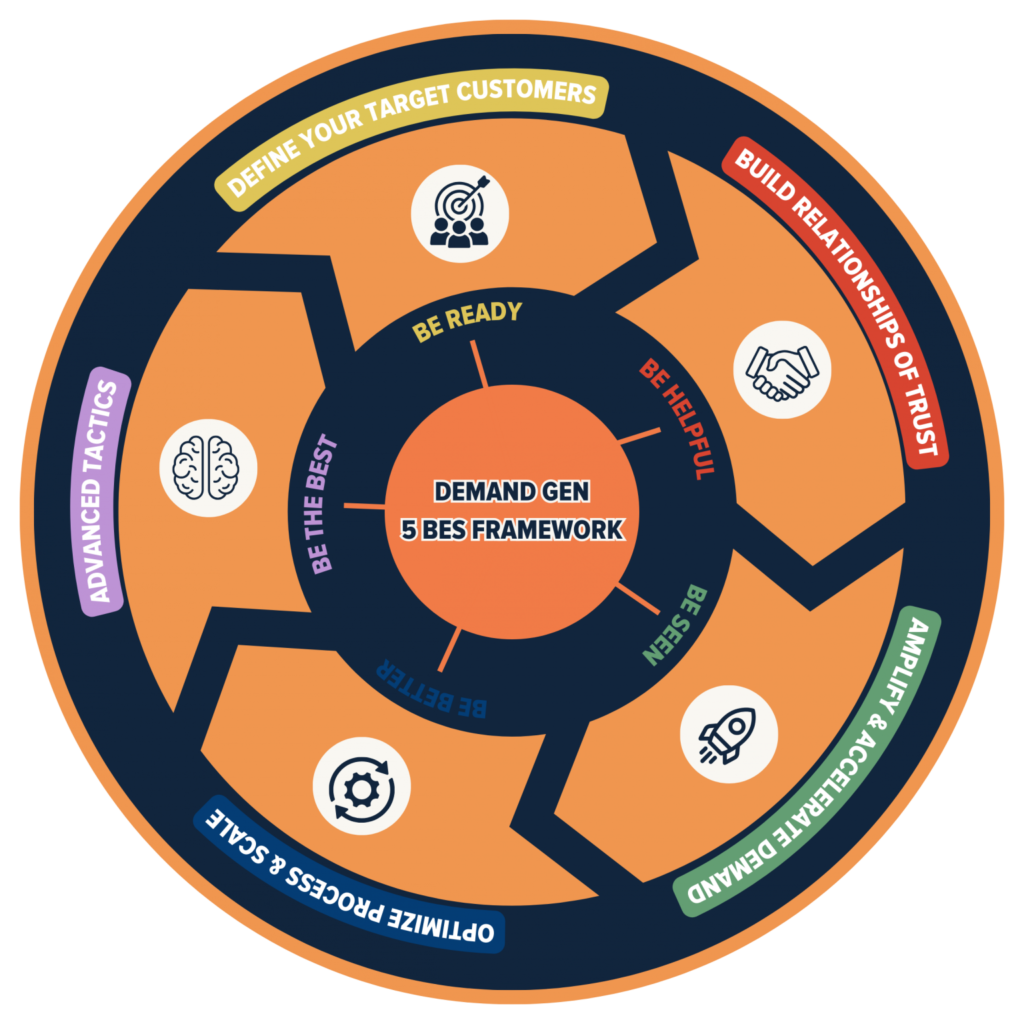
Next, we have Be Helpful. This is where most marketers drop the ball. Being helpful isn’t about pushing your product—it’s about creating valuable, educational content that actually answers your audience’s questions. This builds trust over time, and when they’re ready to buy, you’ll already be seen as the expert. The key here is to let your subject matter experts drive the content, and then distribute it in the places your audience is already hanging out.
The third BE, Be Seen, is about accelerating that process. Once you’ve got great content, use paid media to get it in front of the right people. This helps you speed up the relationship-building process and reach more of your future buyers.
The final two BEs—Be Better and Be Best—are more advanced. Be Better is about optimizing what’s already working. Think A/B testing, CRO, and advanced repurposing strategies. Be Best takes it to the next level, using more sophisticated tactics like neuroscience and psychology to influence your audience.
We’ve applied the 5 BEs Framework in everything we do at The B2B Playbook, and it’s been a game-changer. It’s how we’ve grown our audience and built long-term relationships with B2B marketers. If you’re serious about demand generation, this framework will give you the roadmap to do it right.
You can learn how to do it on The B2B Playbook podcast. We also ‘force’ you to implement it in your business in our 12 Week Demand Generation Course – The B2B Incubator.
ABM and Its Future in B2B Demand Generation
So how does ABM fit into Demand Generation? Account-based marketing (ABM) is one of those things that a lot of companies talk about, but very few are actually doing right. There’s this idea that ABM is about buying a fancy platform, loading it up with a list of your dream accounts, and hitting them with outbound emails and display ads. But that’s not what ABM is about—at least, not if you want it to work.
True ABM is about deep, one-to-one engagement. It’s about really understanding your high-value accounts, building relationships, and guiding them through a tailored experience. It’s not a one-to-many strategy—it’s one-to-one. And that’s where most marketers get it wrong. They treat ABM like another mass marketing channel, when in reality, it should be the opposite.
If you want to do ABM right, start small. Don’t try to target a hundred accounts right off the bat. Instead, focus on 10 or 20 accounts that are already showing some level of intent—maybe they’ve visited your website, engaged with your content, or shown interest in your product. You don’t even need an expensive platform to start. Honestly, you can run a great ABM program out of a spreadsheet if you know what you’re doing.
ABM works beautifully alongside demand generation because it helps you accelerate the sales process for high-value accounts. While demand generation is about building long-term relationships at scale, ABM allows you to focus that effort on your most important accounts. But the key here is trust. You’re not blasting ads—you’re building real, meaningful connections.
We’ve applied ABM in our own business by inviting key accounts onto our podcast, hosting small roundtables, and engaging with them on a personal level. It’s about creating meaningful interactions that lead to lasting relationships, and that’s where ABM really shines. If you’re serious about driving growth for high-value accounts, ABM is the way to do it—but you have to get it right from the start.
The Role of GenAI in Demand Generation
We wrapped up our conversation with Denave discussing the role of GenAI in Demand Generation. AI certainly has its place, but it should never replace the foundational work of understanding your customers. I’ve seen marketers skip critical steps like customer research and just ask ChatGPT what their audience wants. That’s a huge mistake. AI can’t replace the insights you get from talking to real customers, understanding their pain points, and learning how they think.
In our team, we use AI, but I feel we use it the right way. For us, it’s a tool for content repurposing, not content creation. We record our own original content—like our podcast—which is based on real insights, experiences, and stories. Once we have that, we use AI to help turn it into blog posts, LinkedIn updates, articles, and more. But the key is that it all starts with us. The foundation is human-driven. It’s our expertise, our stories, our voice.
Now, what I see happening a lot in outbound marketing is people trying to use AI for mass personalization. You know the type—those templated emails that mention your name and maybe congratulate you on a new role. The problem is, it’s not genuine. People can see through it. In the end, relevance trumps personalization every time. Instead of trying to fake a personal connection, focus on offering something that’s actually relevant to the person you’re reaching out to.
AI can definitely help speed up processes, but it’s not a shortcut to great marketing. You need to combine it with real human insights and genuine connection. That’s where the magic happens. Don’t let AI make you a lazy marketer—use it to enhance your work, not replace the fundamentals..
Next Steps
Demand generation isn’t just a tactic—it’s a mindset shift. It’s about moving away from chasing short-term wins and focusing on building long-term relationships with your audience. Whether it’s understanding the difference between demand creation and demand capture, bridging the divide between sales and marketing, or using frameworks like the 5 BEs, the goal is the same: create sustainable growth by building trust.
Too many marketers get stuck in the lead gen hamster wheel or ‘capturing demand’ alone, competing for the same small slice of buyers. But if you want to stay ahead of your competition, you need to start thinking long-term. That means having a system for building trust with future buyers.
If you take one thing away from this, let it be this: invest in building relationships, not just capturing leads. It’s about playing the long game. Get those fundamentals in place, and everything else will follow.
Ready to start generating demand for your business? Get out there, focus on your audience, and remember—demand generation is what will keep you growing long after your competitors have burned through their leads.
